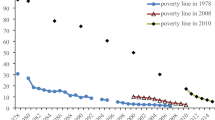Abstract
Along with the rapid economic growth since 1978, there has been a remarkable trend in China, i.e. the steady decline of the share of final consumption expenditure in GDP that has made China one of economies with a low consumption rate in the world for a long time period. This phenomenon is concerned by economists since it is important for economic policies given the key role of consumption in the economic growth. This paper is to explore causes about decline in China’s final consumption rate since the economic reform. Evidence implies four causes: decrease of consumption propensity, adjustment of national income distribution structure, reform of urban housing system and slow growth of rural income.




Similar content being viewed by others
References
Chen, L. P. (2005). Growth and saving: An explanation based on catching up with the Joneses. World Economy, 11, 3–10. (in Chinese).
Gao, C. C., & Jin, J. (2006). An investigation on economics of China’s low household consumption rate. Commercial Research, 20, 21–24. (in Chinese).
Ge, Z. C., & Kang, N. (2007). Hindered growth of China’s household consumption rate—An analysis on the disequilibrium of the structure of national income distribution. Business Culture, 9, 255–256. (in Chinese).
Institute of Finance and Banking of Chinese Academy of Social Sciences. (2007). The growth of China’s macroeconomics: Stable and slightly fast. Chinese Academy of Social Sciences Review, 11, 16–29. (in Chinese).
Jin, B. (2007). The report on China’s enterprises competitiveness. The profitability and competitiveness. Beijing: Social Sciences Academic Press. (in Chinese).
Li, J. W. (2007). International comparison of the evolution characteristics of the consumption rate and investment rate. China Finance, 8, 49–51. (in Chinese).
Liu, J. R., Wang, R. S., & Yang, J. X. (2005). Metabolism and driving forces of Chinese urban household consumption. Population and Environment, 26(4), 325–341. (in Chinese).
Luo, Y. Y. (2007). Researches on consumption–investment relations. Beijing: China Planning Press. (in Chinese).
Luo, Z. Y., & Liu, Z. H. (2005). An empirical analysis on the change of China’s household consumption propensity and its influencing factors. Consumer Economics, 21(3), 14–17. (in Chinese).
National Bureau of Statistics of China. (1999–2008a). China statistical yearbook. Beijing: China Statistics Press. (in Chinese).
National Bureau of Statistics of China. (1999–2008b). Statistical Communiqué of the People’s Republic of China on national economic and social development. Beijing: China Statistics Press. (in Chinese).
National Bureau of Statistics of China. (2009). China statistical abstract. Beijing: China Statistics Press. (in Chinese).
Qiao, W. G. (2007). The causes of China’s low consumption rate—An analysis in the framework of flow circulation of national income. Academia Bimestris, 5, 141–146. (in Chinese).
Qin, D. (2003). Determinants of household savings in China and their role in quasi-money supply. Economics of Transition, 11(3), 513–537. (in Chinese).
Song, Z. (1999). Analysis of Chinese saving behavior. Journal of Finance, 6, 46–51. (in Chinese).
Wan, G. H., Zhang, Y., & Niu, J. G. (2001). Liquidity constraints, uncertainty and household consumption in China. Economic Research Journal, 11, 35–45. (in Chinese).
Wang, Z. Y. (2008). National income distribution: Be inclined to the government day by day. Outlook, 2, 28. (in Chinese).
Wen, J. B. (2004). Report on the Work of the Government (2004). Retrieved March 20, 2008, from www.gov.cn/english/official/2008-03/20/content_924600.htm
World Bank. (2000, 2004). World Development Indicators. Retrieved June 22, 2009, from www.worldbank.org
World Bank. (2002–2009). World Development Reports. Retrieved June 22, 2009, from www.worldbank.org
Wu, Y. F., & Qian, M. Z. (2004). An empirical analysis on the factors that affecting the consumption demand. Economic Theory and Business Management, 2, 13–16. (in Chinese).
Xu, Y. B. (2005). Further study about the causes of decline of domestic consumption. Finance and Trade Economics, 12, 51–54. (in Chinese).
Yang, T. Y. (2005). China’s urbanization and within-urban inequality: Theory and its test. Journal of Renmin University of China, 4, 71–76. (in Chinese).
Yuan, Z. G., & Song, Z. (2000). The age composition of population, the endowment insurance system and optimal savings ratio in China. Economic Research Journal, 11, 24–33. (in Chinese).
Zang, X. H., & Pei, C. X. (2004). Econometric analysis of the precautionary savings, liquidity constraints and household consumption in China. Economic Perspectives, 12, 28–31. (in Chinese).
Zheng, X. L. (2007). Improving household consumption rate is an important task of micro-control. Macroeconomic Management, 9, 16–17. (in Chinese).
Author information
Authors and Affiliations
Corresponding author
Rights and permissions
About this article
Cite this article
Xu, G., Dai, L. & Zhong, J. Why Has China’s Final Consumption Rate Declined Since 1978? Causes and Implications. J Fam Econ Iss 31, 338–352 (2010). https://doi.org/10.1007/s10834-010-9209-0
Published:
Issue Date:
DOI: https://doi.org/10.1007/s10834-010-9209-0




